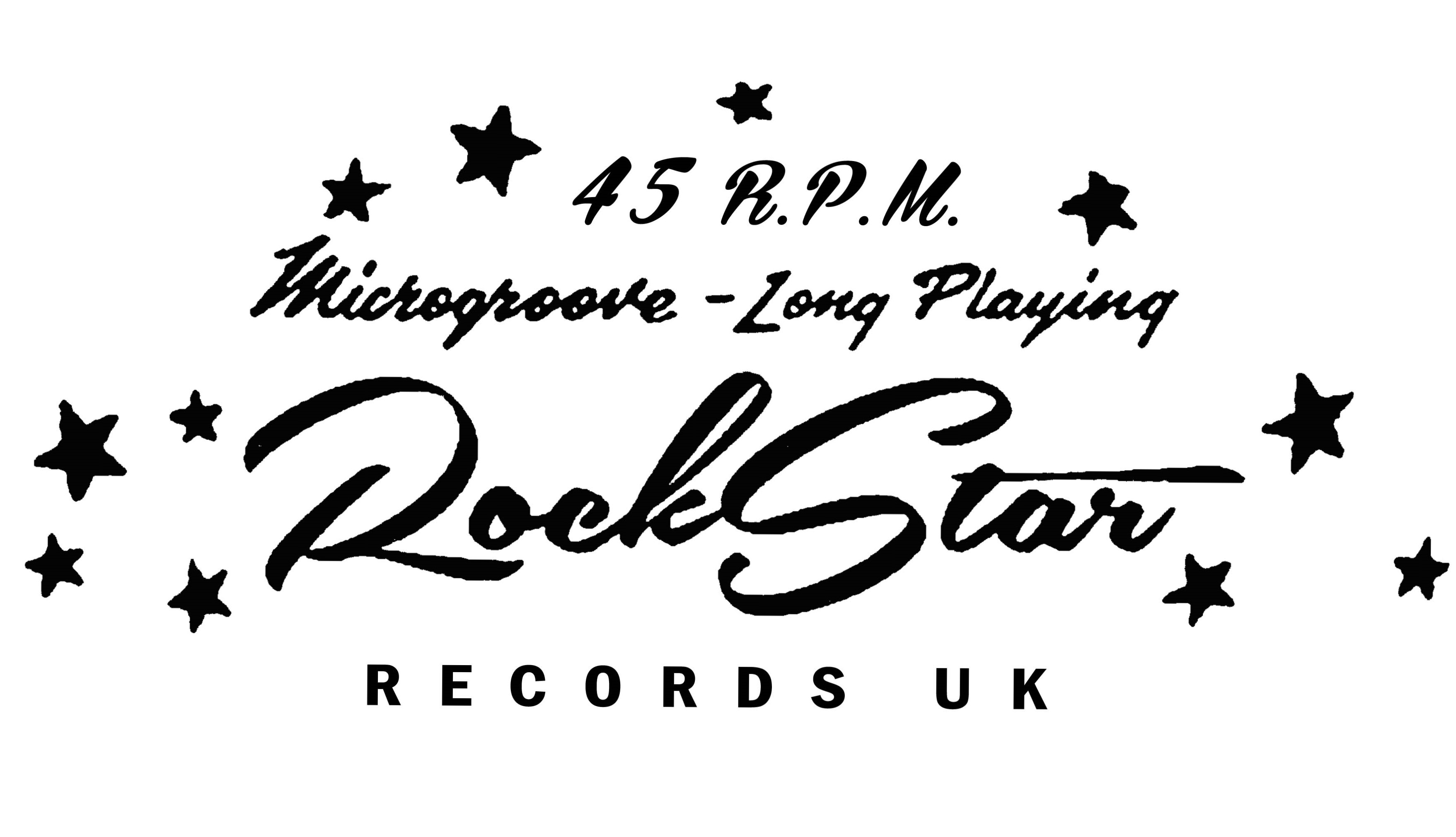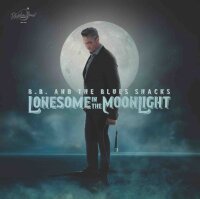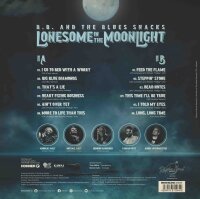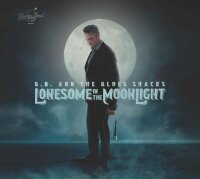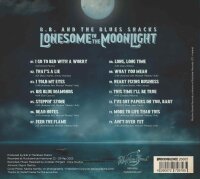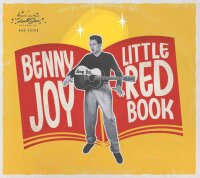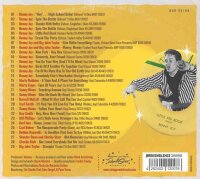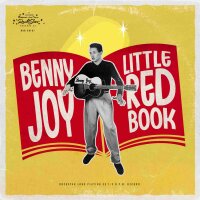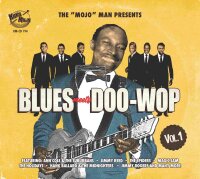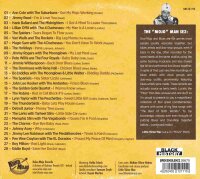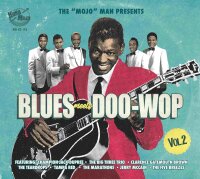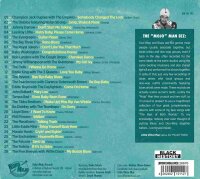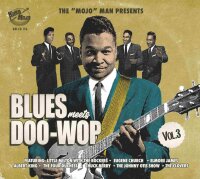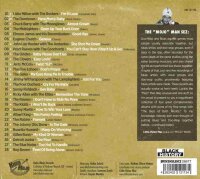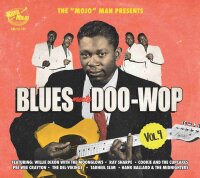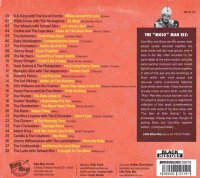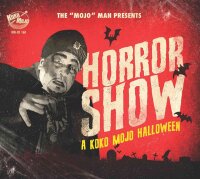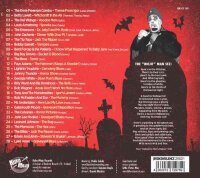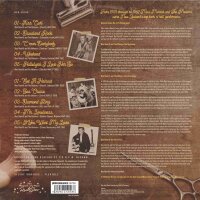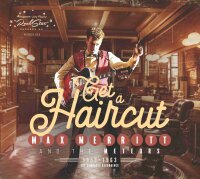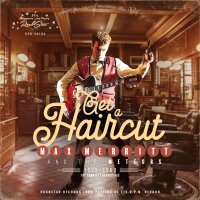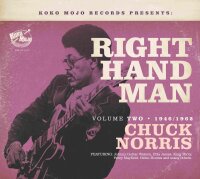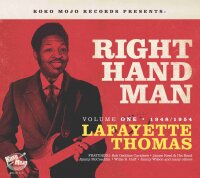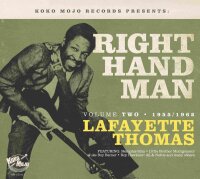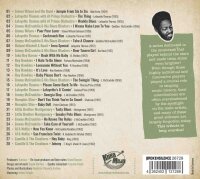Dayvk Martins
Dayvk Martins
Artikel 1 - 15 von 15
Lonesome In The Moonlight is the fourth album from B. B. and The Blues Shacks recorded for the German label Rhythm Bomb Records.
Lonesome In The Moonlight is the fourth album from B. B. and The Blues Shacks recorded for the German label Rhythm Bomb Records.
Rockstar Records ten-song, 10-inch album Benny Joy, Little Red Book, has been made into a twenty-nine song CD album. The featured songs are all from the years 1957 to 1963, and showcase prime recordings in the following genres; Rockabilly, Rock 'n' Roll, pop, and Country. Gracing the album with their musical presence are; "Big" John Taylor, Marty Robbins, Sonny Hines, Darrell McCall, Carl Smith, Ray Smith, Charlie Rich, and several others. The CD album further more includes the Dixie version of Spin The Bottle which was the undubbed master leased to Shelby Singleton who added his name to the writing credits. The album reissues several songs for the first time ever, and the album showcases the writing skills of Benny Joy.
Dee Jay Mark Armstrong Bühl, Germany
is a 10 track 10inch record that comes with a CD with bonus songs. Its the first release that will be out on Rockstar to celebrate 50 years of Rockstar Records in 2024. Due to legal issues it wont hit the USA. Limited to 500 copies and of course no reprints.
Doo-wop is not just for Christmas. A genre often associated with the festive period at the tail end of every year, and synonymous with a picture book setting of Christmas given the radiating warmth of harmonious vocals encased in gold, and emanating from the voices of a truly gifted combo. A false representation however, because doo-wop is music fit for any occasion.
Much more than the imaginative associations of a Christmas backdrop that, granted, doo-wop possesses the power to conjure such picturesque imagery, but on an entirely different trajectory doo-wop also has the ability to portray emotions where melancholy is present whether due to economic hardships or universal theme of relationship woes. It’s in these moments where we all feel something, and there is no genre better equipped with the right utensils (i.e. Vocals) to convey such emotions, in addition to providing solace from difficulties that life has a tendency to produce.
Different in comparison with the wild shenanigans of rock ‘n’ roll, and different given the approach of this latest compilation series from the good folks at Koko Mojo, the genre of doo-wop makes numerous connections with the genre of blues during Blues Meets Doo Wop Volume 1.
Doo-wop is not just for Christmas. A genre often associated with the festive period at the tail end of every year, and synonymous with a picture book setting of Christmas given the radiating warmth of harmonious vocals encased in gold, and emanating from the voices of a truly gifted combo. A false representation however, because doo-wop is music fit for any occasion.
Much more than the imaginative associations of a Christmas backdrop that, granted, doo-wop possesses the power to conjure such picturesque imagery, but on an entirely different trajectory doo-wop also has the ability to portray emotions where melancholy is present whether due to economic hardships or universal theme of relationship woes. It’s in these moments where we all feel something, and there is no genre better equipped with the right utensils (i.e. Vocals) to convey such emotions, in addition to providing solace from difficulties that life has a tendency to produce.
Different in comparison with the wild shenanigans of rock ‘n’ roll, and different given the approach of this latest compilation series from the good folks at Koko Mojo, the genre of doo-wop makes numerous connections with the genre of blues during Blues Meets Doo Wop Volume 2.
Doo-wop is not just for Christmas. A genre often associated with the festive period at the tail end of every year, and synonymous with a picture book setting of Christmas given the radiating warmth of harmonious vocals encased in gold, and emanating from the voices of a truly gifted combo. A false representation however, because doo-wop is music fit for any occasion.
Much more than the imaginative associations of a Christmas backdrop that, granted, doo-wop possesses the power to conjure such picturesque imagery, but on an entirely different trajectory doo-wop also has the ability to portray emotions where melancholy is present whether due to economic hardships or universal theme of relationship woes. It’s in these moments where we all feel something, and there is no genre better equipped with the right utensils (i.e. Vocals) to convey such emotions, in addition to providing solace from difficulties that life has a tendency to produce.
Different in comparison with the wild shenanigans of rock ‘n’ roll, and different given the approach of this latest compilation series from the good folks at Koko Mojo, the genre of doo-wop makes numerous connections with the genre of blues during Blues Meets Doo Wop Volume 3.
Doo-wop is not just for Christmas. A genre often associated with the festive period at the tail end of every year, and synonymous with a picture book setting of Christmas given the radiating warmth of harmonious vocals encased in gold, and emanating from the voices of a truly gifted combo. A false representation however, because doo-wop is music fit for any occasion.
Much more than the imaginative associations of a Christmas backdrop that, granted, doo-wop possesses the power to conjure such picturesque imagery, but on an entirely different trajectory doo-wop also has the ability to portray emotions where melancholy is present whether due to economic hardships or universal theme of relationship woes. It’s in these moments where we all feel something, and there is no genre better equipped with the right utensils (i.e. Vocals) to convey such emotions, in addition to providing solace from difficulties that life has a tendency to produce.
Different in comparison with the wild shenanigans of rock ‘n’ roll, and different given the approach of this latest compilation series from the good folks at Koko Mojo, the genre of doo-wop makes numerous connections with the genre of blues during Blues Meets Doo Wop Volume 4.
Have yourself a great Halloween with "Horror Show" on Koko-Mojo Records, a magnificent compilation that features 28 fun-tastic spooky tracks selected for you by DJ "Moko" Man - a.k.a. Little Victor Mac.
is a 10 track 10inch record that comes with a CD with bonus songs. Its the first release that will be out on Rockstar to celebrate 50 years of Rockstar Records in 2024. Due to legal issues it wont hit the USA. Limited to 500 copies and of course no reprints.
"Max Merritt and The Meteors were New Zealand's first and hottest rockin' band who during the vibrant years 1959 through to 1963 championed the new music in their birth land and Australia. Rockstar Records collection Get A Haircut showcases the trailblazing sound of rock 'n' roll music in the Eastern and Southern Hemispheres."
The Rockstar Records anthology is shone upon Max Merritt and The Meteors who were the longest-lived and the most popular band from New Zealand in the early rock 'n' roll era. The ten-song, ten-inch vinyl album with recordings from the years 1959 to 1963 is entitled Max Merritt and The Meteors, Get A Haircut, and it additionally has a free chronologically arranged twenty-four-song CD, which will also have a commercial release. Their legacy which is re-issued on this Rockstar Records LP and CD comprises; four 45 RPMs and the songs from their LP C'mon Let's Go.
Dee Jay Mark Armstrong Bühl, Germany
"Max Merritt and The Meteors were New Zealand's first and hottest rockin' band who during the vibrant years 1959 through to 1963 championed the new music in their birth land and Australia. Rockstar Records collection Get A Haircut showcases the trailblazing sound of rock 'n' roll music in the Eastern and Southern Hemispheres."
Rockstar Records present a 24 track CD album entitled Max Merritt and The Meteors, Get A Haircut. The CD album is programmed in chronological order and comprised of original and cover songs from the years 1959 through to 1963. The Rockstar Records anthology is shone upon Max Merritt and The Meteors who were the longest-lived and the most popular band from New Zealand in the rock 'n' roll era. They were the hottest band to set the trend in New Zealand, and their legacy for this release comprises; four 45 RPMs and the songs from their LP C'mon Let's Go.
Dee Jay Mark Armstrong Bühl, Germany
Chuck Norris Vol.1 1946-1955
Norris originates from the Midwest, born in Kansas City, Missouri on August 11, 1921, and raised in Chicago, where he studied under the fabled music instructor Captain Walter Dyett at Chicago's DuSable High School.
Here, he learned to read music, and his versatility and keeping up with the trends kept him in constant demand, resulting in a career that spanned four decades.
In the mid-40s, Norris relocated to Los Angeles where his performances in local clubs caught the attention of independent labels and producers, particularly saxophonist, songwriter, and producer Maxwell Davis, whose connections across labels like Aladdin, Modern, and Specialty provided Norris with plenty of opportunities for session work.
In the 40s and early 50s, the West Coast served as the cradle of R&B, blending diverse musical genres. It amalgamated small, almost pop-styled combos with the blues of Texas and the big band influences of the Midwest.
Throughout his career, he released just 16 solo tracks. These releases primarily served to fill gaps in the company's catalog rather than being seen as long-term investments, and as so they had limited distribution and were pressed in small quantities, making many of them nearly impossible to find today.
Not many realize that they have heard Chuck’s guitar or bass on countless recording sessions by everybody from Charles Brown and Dinah Washington to Percy Mayfield and Jesse Belvin and on bestselling records by Bobby Day, The Robins, The Platters, and The Rivingtons. His resume also includes a session for an X-rated movie, and a soundtrack for the movie "The Great White Hope". He even did a month-long stint playing the banjo behind Louis Armstrong and Barbara Streisand on "Hello Dolly”.
Other than a great interview on the back of Swedish LP "Los Angeles Flash" recorded in 1982, there is limited documentation of his career, and no official collection of his work exists. Until now.
Norris’ earliest recordings lean more towards jazz and later the refined urban blues stylings of Floyd Dixon and Charles Brown whose styles owed a lot to the smooth velvety pop of Nat King Cole. When Charles Brown departed from the Three Blazers in 1948, he established his own trio The Smarties with Eddie Williams on bass and Norris on guitar.
As a guitarist Norris (and his close friend T-Bone Walker) was heavily influenced by Charlie Christian, but he had to adjust to keep working. More and more he had to abandon jazz and his idol. Jules Bihari of Modern Records started using Norris on sessions behind Floyd Dixon, Jimmy Witherspoon, and Little Willie Littlefield and he wanted nothing but Blues, and soon Norris was playing nothing but The Blues.
Norris’ first solo outing was with the Charles Norris Trio-No Better For Me b/w Moneys Getting Cheaper (Personnel unknown). The latter became a Jimmy Witherspoon standard as "Time's Getting Tougher Than Tough". Notice the very cool tremolo guitar!
"Hey Everybody" and "Kinda Sick, Mostly Worried" were both recorded on December 28, 1950, and feature Tom Reeves (trumpet), Early Brow (alto sax), Maxwell Davis (tenor sax), Jim Wynn (baritone sax), Jesse Belvin (piano), Warren Owens (bass), and Peppy Prince (drums).
To be continued on Vol. 2 where we will feature more Chuck Norris solo sides, and outstanding tracks recorded between 1946 and 1962 with artists such as Pearl Traylor, Percy Mayfield, Johnny Guitar Watson, Linda Hopkins, and Larry Williams!
Chuck Norris VOL.2 1946-1962
Norris originates from the Midwest, born in Kansas City, Missouri on
August 11, 1921, and raised in Chicago, where he studied under the
fabled music instructor Captain Walter Dyett at Chicago's DuSable High
School.
Here, he learned to read music, and his versatility and keeping up with
the trends kept him in constant demand, resulting in a career that
spanned four decades.
In the mid-40s, Norris relocated to Los Angeles where his performances
in local clubs caught the attention of independent labels and producers,
particularly saxophonist, songwriter, and producer Maxwell Davis, whose
connections across labels like Aladdin, Modern, and Specialty provided
Norris with plenty of opportunities for session work.
In the 40s and early 50s, the West Coast served as the cradle of R&B,
blending diverse musical genres. It amalgamated small, almost pop-styled
combos with the blues of Texas and the big band influences of the Midwest.
Throughout his career, he released just 16 solo tracks. These releases
primarily served to fill gaps in the company's catalog rather than being
seen as long-term investments, and as so they had limited distribution
and were pressed in small quantities, making many of them nearly
impossible to find today.
Not many realize that they have heard Chuck’s guitar or bass on
countless recording sessions by everybody from Charles Brown and Dinah
Washington to Percy Mayfield and Jesse Belvin and on bestselling records
by Bobby Day, The Robins, The Platters, and The Rivingtons. His resume
also includes a session for an X-rated movie, and a soundtrack for the
movie "The Great White Hope". He even did a month-long stint playing the
banjo behind Louis Armstrong and Barbara Streisand on "Hello Dolly”.
Other than a great interview on the back of Swedish LP "Los Angeles
Flash" recorded in 1982, there is limited documentation of his career,
and no official collection of his work exists. Until now.
Norris’ earliest recordings lean more towards jazz and later the refined
urban blues stylings of Floyd Dixon and Charles Brown whose styles owed
a lot to the smooth velvety pop of Nat King Cole. When Charles Brown
departed from the Three Blazers in 1948, he established his own trio The
Smarties with Eddie Williams on bass and Norris on guitar.
For Vol. 2 we have featured more Chuck Norris solo sides, and
outstanding tracks recorded between 1946 and 1962 with artists such as
Pearl Traylor, Percy Mayfield, Johnny Guitar Watson, Linda Hopkins, and
Larry Williams!
According to an article in Living Blues magazine in 1977 "There is hardly a guitarist around here today who doesn't owe a little something to Lafayette Thomas."
He has been called "one of the finest guitarists to emerge from the San Francisco-Oakland Blues scene."
I would say "one of the finest players ever." Period.
Many of his solos contain jaw-dropping ideas that will make any aspiring Blues guitarist go "Whoa! What was that!?" and move the needle back in the grooves again and again to try to learn that crazy lick he just did—I know I have.
Just listen to "West Side Jump," and you'll see what I mean.
Compiling all the sides Lafayette Thomas ever played on, and then selecting 28 sides that contain his best playing, has been quite a task! I don't think he ever played an uninspired solo, and his ideas just seemed to flow from him. His style was sharp, and intense, and he would switch sounds and styles to match the song.
His playing ranged from dynamic and edgy, to aggressive and heavily distorted and he’d effortlessly transition between a down-home Blues and a beautiful ballad.
Lafayette Jerl Thomas came into the world on June 13, 1928, in Shreveport, Louisiana. His first exposure to The Blues was most likely through his uncle Jesse "Babyface" Thomas. By the late 1940s, he was living in San Francisco, where he played with Al Simmons Rhythm Rockers, Bob Geddins' Cavaliers, and the great Jimmy Wilson of "Tin Pan Alley" fame. In 1948, Thomas appeared on wax for the first time on the B-side of a Bob Geddins record.
The track was Shermans Trio ‘Jumpin For Julia’ with pianist Sherman Louis and bass player Bill Bostick.
Bob Geddins was the owner of the Art-Tone, Big Town, Cava-Tone, Downtown, Irma, Plaid, Rhythm, and Veltone labels, and he leased records to Swing-Time, Aladdin, Modern, Checker, and Imperial. Thomas remained closely connected to Geddins and appeared on his releases from his 1948 debut and all well into the mid-1960s.
Thomas’ first solo record, ‘Sam's Drag/ Baby Take a Chance On Me’ was released as L.J. Thomas and his Louisiana Playboys. If you think it sounds like something straight out of Sam Phillips Sun studios, you're right. The record was made by Sam Phillips and leased to Chess Records in 1952. ‘Sam's Drag’ rocks, and his T-Bone Walker influence really shines through on the flip side.
During the fifties and sixties, Thomas appeared on more than a hundred records—most prominently with Jimmy McCracklin & his Blues Blasters, whom he joined in early 1951, replacing Robert Kelton on guitar. (Thomas and Kelton share the guitar duties on ‘Rockin' All Day’).
He would record and perform with McCracklin, off and on, for pretty much the remainder of his career.
Thomas also appeared on great sides with Jimmy Wilson, Roy Hawkins, Willie Huff, and James Reed. Both Jimmy Wilson and James Reeds versions of the now classic ‘Tin Pan Alley’ are included here.
The 1953 track ‘Instrumental Jump’ was released on Big Town and re-released in 1956 on Modern as a filler b-side for rockabilly artist Johnny Todd.
His next solo effort was the brilliant ‘Lost Mind’ (aka ‘Standing In The Back Door Crying’) and ‘Don’t Have To Worry’ (aka "Jumpin’ In The Heart of Town"), released as by Jerry Thomas.
The monumental ‘Strangest Blues’ is often credited to Jimmy Nolen, but it was actually a record by Jimmy Wilson featuring Wild Willie Moore (tenor sax) Johnny Heartsman (bass), unknown drummer and Lafayette Thomas on guitar. It was first released on Rhythm Records 1765 and then re-released on ELKO as by Jimmy Nolen’s Band.
We round this volume off with Johnny Parker & His Orchestra, but fear not! Theres a Volume 2 on the way featuring Lafayette Thomas tracks from 1954-62… to be continued…
Lafayette Thomas Vol.2 1954-62
In 1955, Thomas released his third solo single 'The Thing/Weekly Blues', this time on the tiny Trilyte Records label owned by Ollie Hunt. The 'Thing' moniker was a reference to Thomas’s acrobatic stage manners.
1957 saw his fourth solo release, 'Cockroach Run', a great mid-tempo instrumental, paired with a weird novelty flip side credited to The Jumping Judge & His Court.
Thomas continued to record with Jimmy McCracklin & His Blues Blasters throughout the 1950s, and his playing on 'Beer Tavern Girl' is some of his finest work behind McCracklin. That guitar break is pure genius!
He also did one-off sessions in 1957 and 1958 with Juke Boy Bonner (misspelled Barner) and Big Mama Thornton & The Hi-Tones. Thomas is credited on the Thornton sessions, but I don’t hear any guitar on the A-side, and if there's any guitar on the flip, it's buried somewhere deep in the mix. Too bad because both sides are phenomenal!
In 1958, Thomas recorded for the Rhythm Recordings label again (now named Rhythm Records), this time with pianist Roy Hawkins. He released four brilliant tracks that demonstrate the breadth of Thomas’s playing.
Later in 1958, Thomas relocated to New York City, where he worked with piano players Little Brother Montgomery and Memphis Slim. He appears on Montgomery's 'Tasty Blues' LP released in 1961 and Memphis Slim's 'Just Blues' LP, also from 1961 (later reissued as ‘Bluesville’).
In 1959, he released his fifth solo single, 'Please Come Back To Me/Lafayette’s A’ Comin’, on Savoy with Sammy Price on piano.
After his time in New York, Thomas returned to California and collaborated with McCracklin once more, this time contributing to McCracklin's album 'Jimmy McCracklin Sings'. He is also featured on singles by Al & Nettie and with Camille And The Creations.
In 1969, he appeared on an Oakland Blues compilation, and in 1972, he appeared on a Sugar Pie DeSanto single. His last recordings were a couple of Soul/Funk records with Papa & The Utopians and The Luscious Three. Lafayette 'Thing' Thomas died of a heart attack in 1977 in Brisbane, California, at the age of 48.
Artikel 1 - 15 von 15
